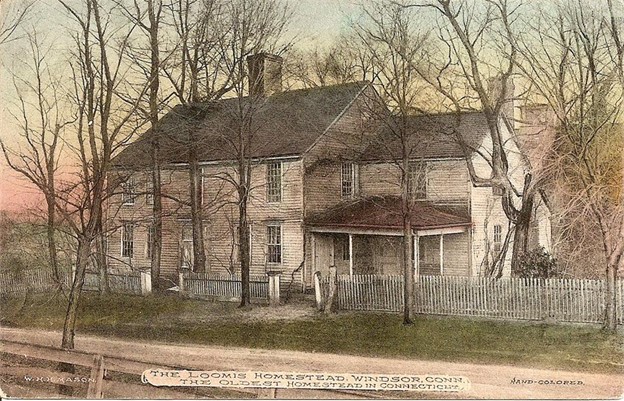
This section covers the ancestors of Arnold Rae Loomis (1897-1980) and his wife, Genevieve Bunline (1904-1982). The Loomis ancestors were predominately English Puritans arriving in New England from 1630 to the end of the 17th century. Edmund Lockwood and Nicholas Knapp both arrived as part of the Winthrop fleet in 1630. Joseph Loomis arrived in Boston in 1638. The Loomis family later moved to the Connecticut River valley and were founders of the towns of Windsor and Hartford.
William Skepper and his wife Susan Fisher emigrated from England 1639. They are the Loomis connection to English, Norman, and Frankish royalty.
Richard Dodge arrived in Salem, Massachusetts, in 1638. You are distantly related to the Dodge brothers of automotive fame through Richard’s father John Dodge (1574-1635).
John Phillips, arrived in 1630. His descendant Seth Phillips was an American Minuteman, part of the militia that fought the British on the day of the battles of Lexington and Concord and participated in George Washington’s siege of Boston. You are also descended from at least, five other Revolutionary War soldiers.
Another ancestor was Johann Phillip Geres, a German immigrant who settled in the Pennsylvania Dutch counties near Philadelphia. There is also a Dutch ancestor, Nicholas Snethen, who was born in Amsterdam in 1640 and emigrated to New Amsterdam (New York) in 1657.
Colonel William Ball was a wealthy Virginia planter who came over in the 1650s. William was one of George Washington’s great-grandfathers, making Joan George Washington’s second cousin, eight times removed.
Thomas Hall (1645-1717) and his wife Catherine Primrose emigrated from Scotland to North Carolina. The Primrose family are the hereditary Lairds of Burnbrae, Scottish nobility, giving the Loomis family a bit of aristocratic Scottish bloodline.

The Revolutionary war generation followed the general migration across the Appalachian Mountains to settle in the newly opened areas of western Ohio. The Phillips family were in Wood County, Ohio just south of Toledo in 1834, the Loomis family by 1835, and Daniel Caris by 1840.
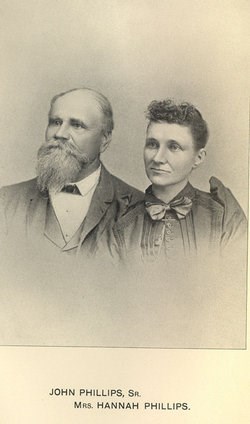
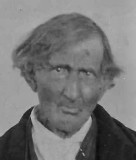
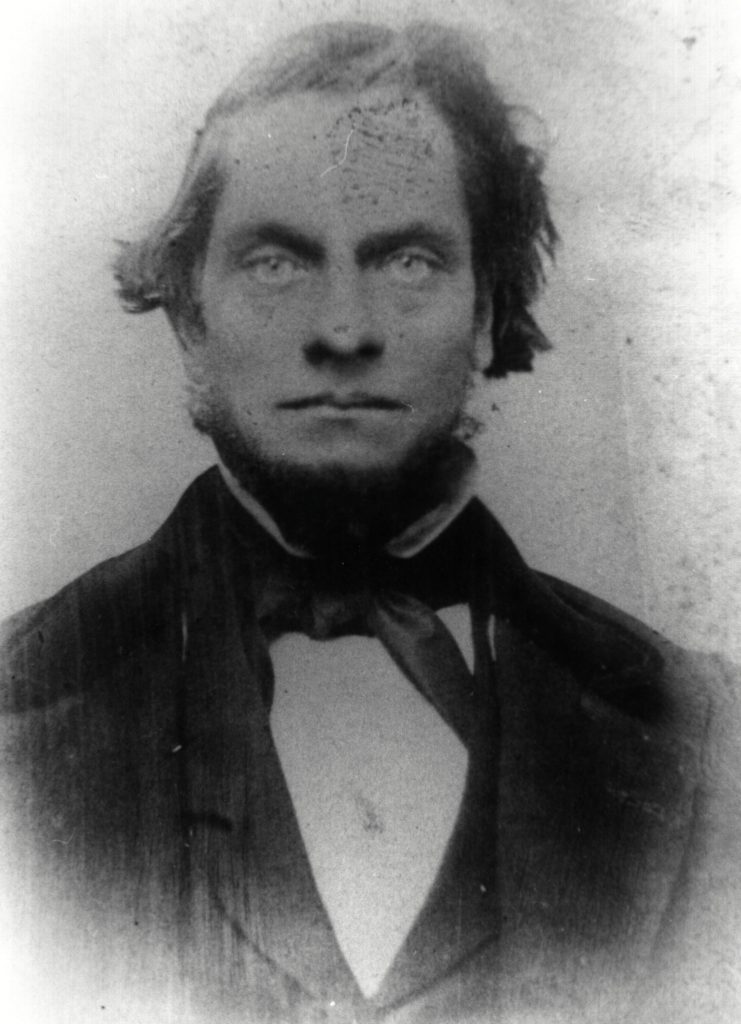
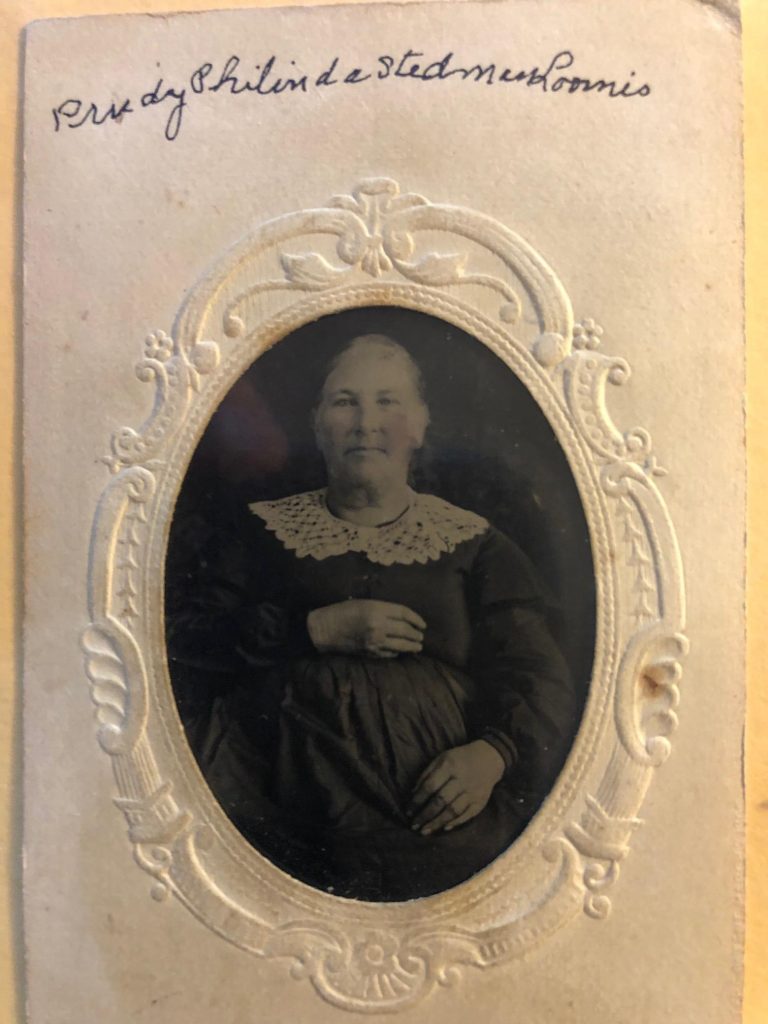
George W. Loomis, his wife Valeria Phillips, and son Arnold Rae Loomis relocated to Perry, Michigan in the first decade of the twentieth century. Arnold married Genevieve Bunline in 1924.
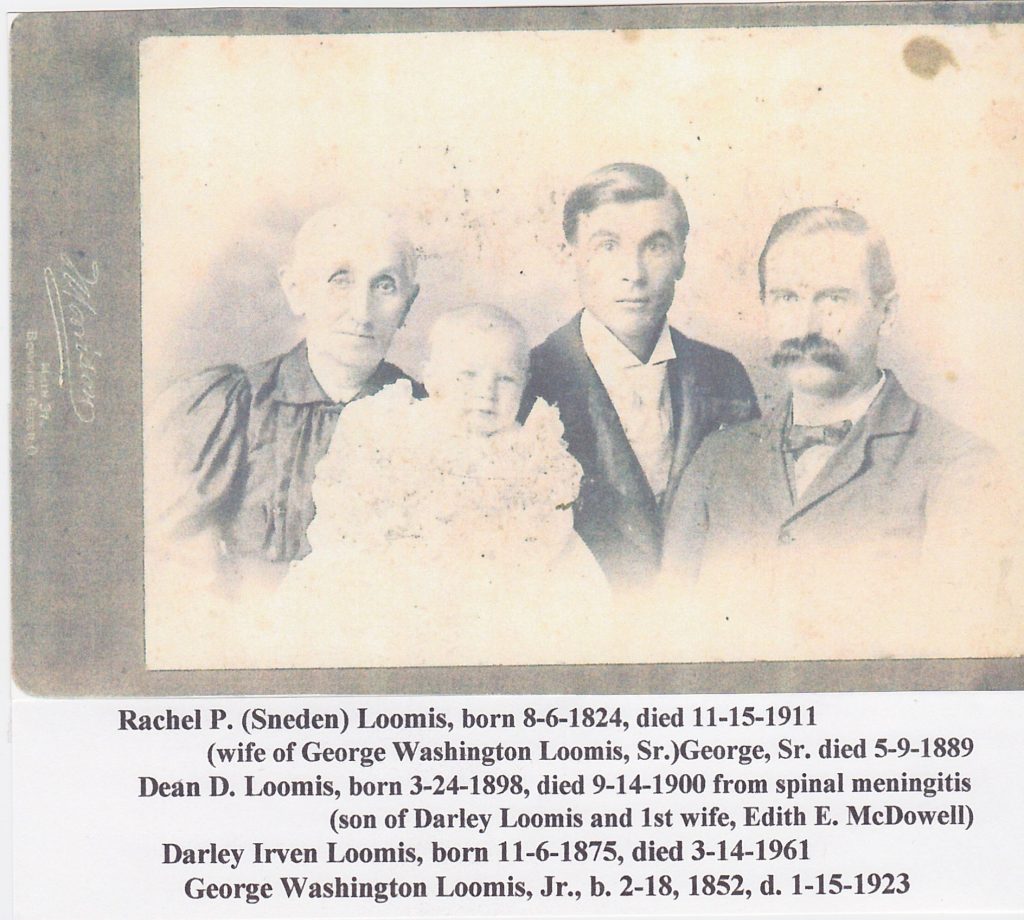
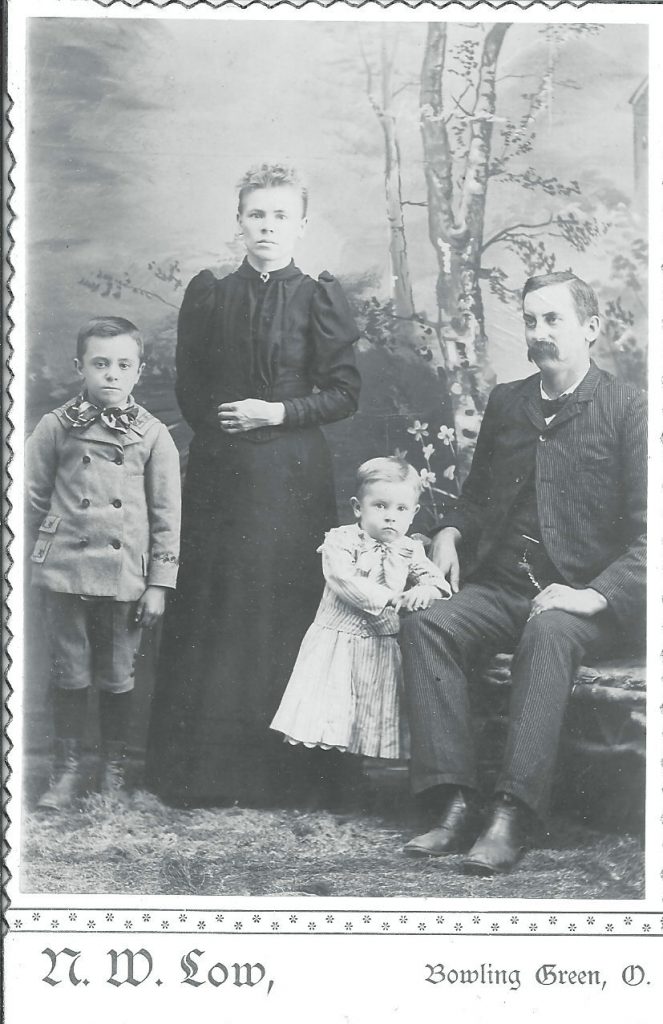
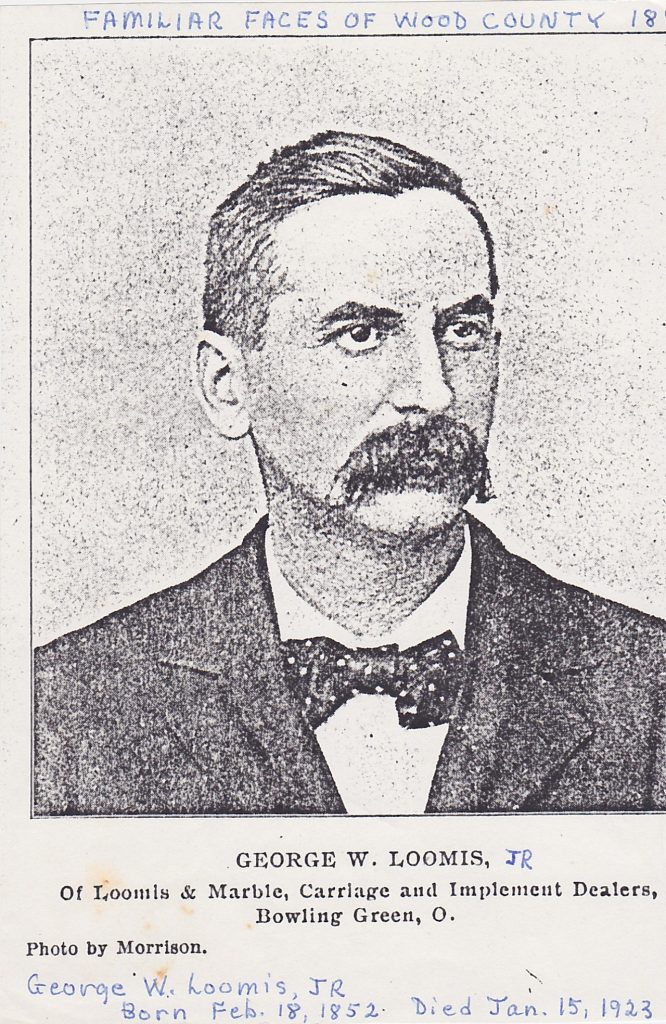

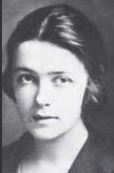
After the section on the Bunline family you can learn about the Loomis colonial generations, Revolutionary War patriots, and the connection to the royalty of western Europe.
Bunline Family
Genevieve’s grandparents were immigrants to the US. Her paternal grandparents, Joseph and Dorothy Huellmantel Bunline came to Michigan from Germany in 1854. Michael and Mary O’Keefe McNamara were both born in County Cork, Ireland. They emigrated from Ireland to Ohio where they married in 1862 and came to Michigan in 1886.
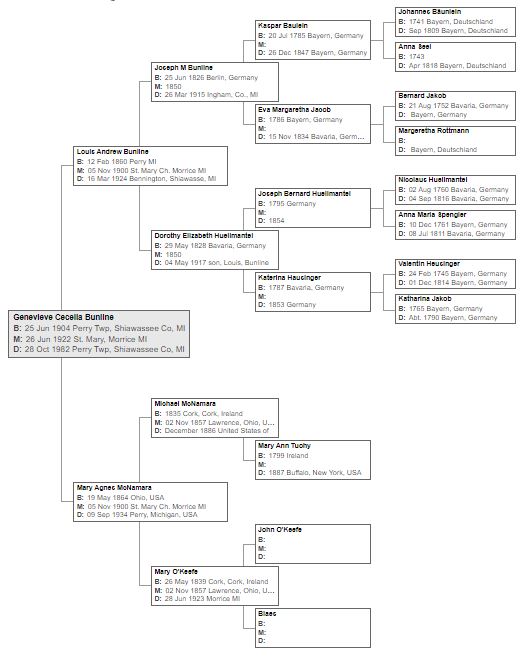
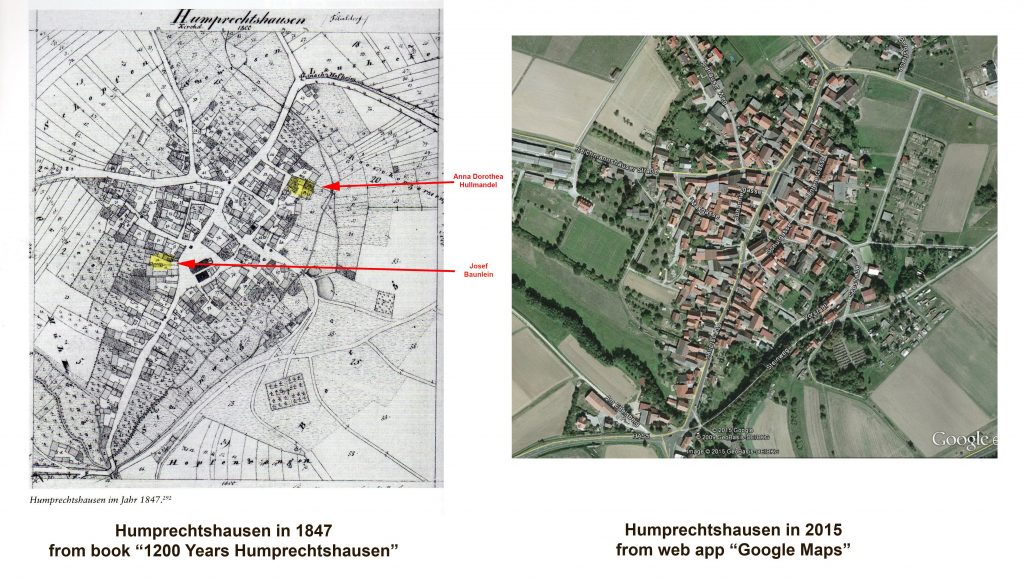
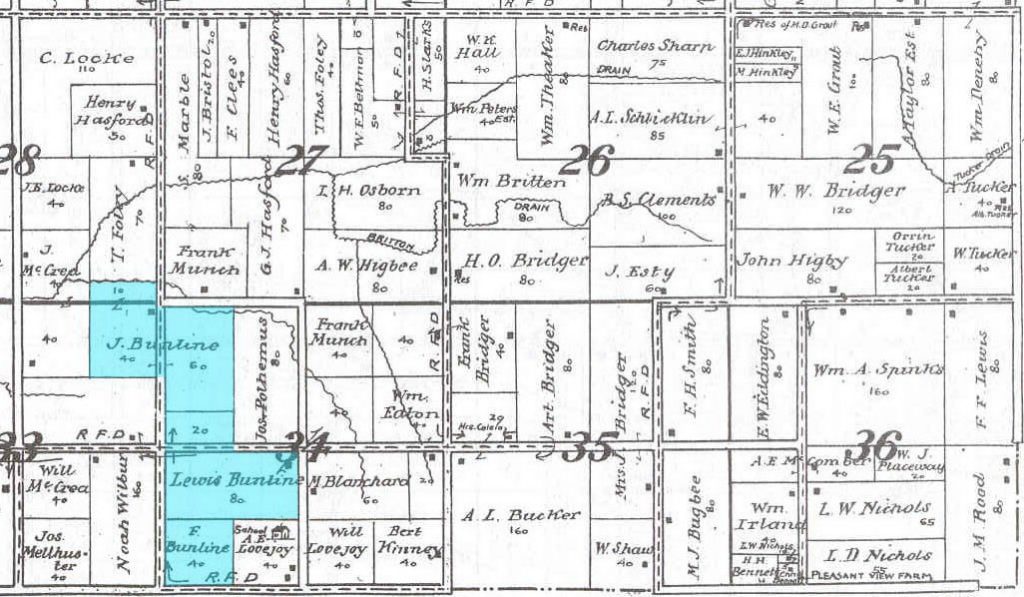
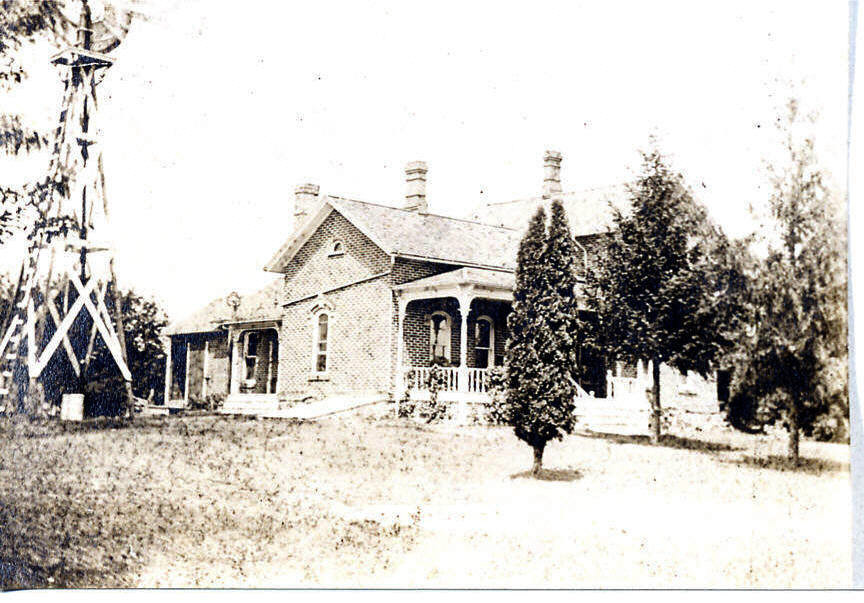
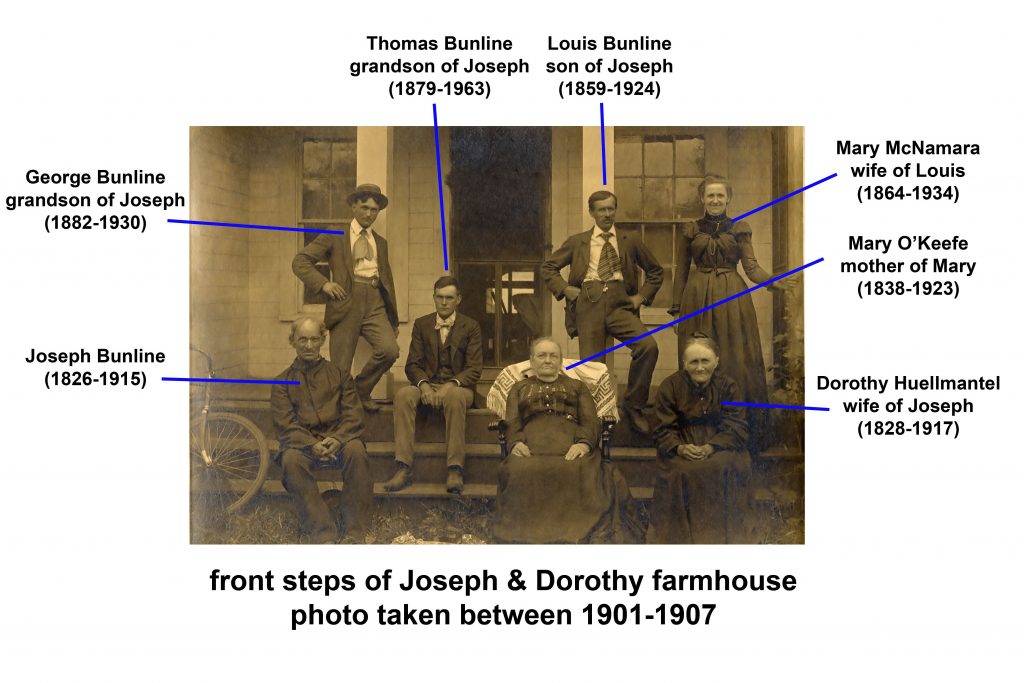
Loomis Colonial Ancestors
Joseph Loomis & Mary White came to America with their 8 children on the ship “Susan & Ellen”. On 11 Apr 1638. They set sail from London, England and arrived in Boston on 17 Jul 1638. They moved to Windsor, CT in 1639.
Joseph was the son of Agnes Lingwood & John Lummys of Thaxted & Braintree & Bocking in Essex, England. Josephs children were Nathaniel; Joseph; Sarah; Elizabeth; John (Ancestor); Thomas; Mary & Samuel.
Joseph Loomis was a woolen draper, a merchant engaged in the purchase of cloth from the many weavers who wove on hand looms in their cottage homes. He had a store in Braintree, Essex, England, stocked with cloths and other goods which a draper usually dealt in. These products he sold both wholesale and retail to tailors and consumers, in general.
Braintree and near-by towns were centers of the cloth manufacture, as many weavers from Flanders had been induced to come to England by Edward III and they had been followed by others in the latter part of the sixteenth century, who had settled in Essex, not far from Braintree, in 1570. Joseph Loomis was in prosperous circumstances and his father-in-law, Robert White, was a man of considerable means for those times. Elder John White was a son of Robert White, and the wives of John Porter and Elder William Goodwin were also daughters of Robert White.
Joseph Loomis was married in the church of Saint Michaels, where the family worshipped and where they are buried. This ancient church was founded in 1199, in the first year of the reign of King John. The coat of arms of the Loomis family is carved on one of the ancient Loomis tombs.
He had access to the funds to make the break with the old world to New England. His goods came from Maiden in Essex by way of Ipswich to London. When he started on his journey to America, he and his family proceeded by land. He sailed with his wife, five sons, and three daughters, from London on 11 April 1638, in the ship “Susan and Ellen” which ship arrived at Boston on July 17th.
After about a year spent in Dorchester, the family moved with the Rev. Ephraim Huet party to Windsor, Connecticut, there arriving August 17, 1639.
By February 1640 Loomis had settled at Windsor, receiving on the 2nd of February, from the Connecticut Plantation, 21 acres adjoining the Farmington River, on the west side (Town Records, Vol. 1). The Massachusetts Bay Colony then had jurisdiction, and he also became owner of several other tracts which he purchased.
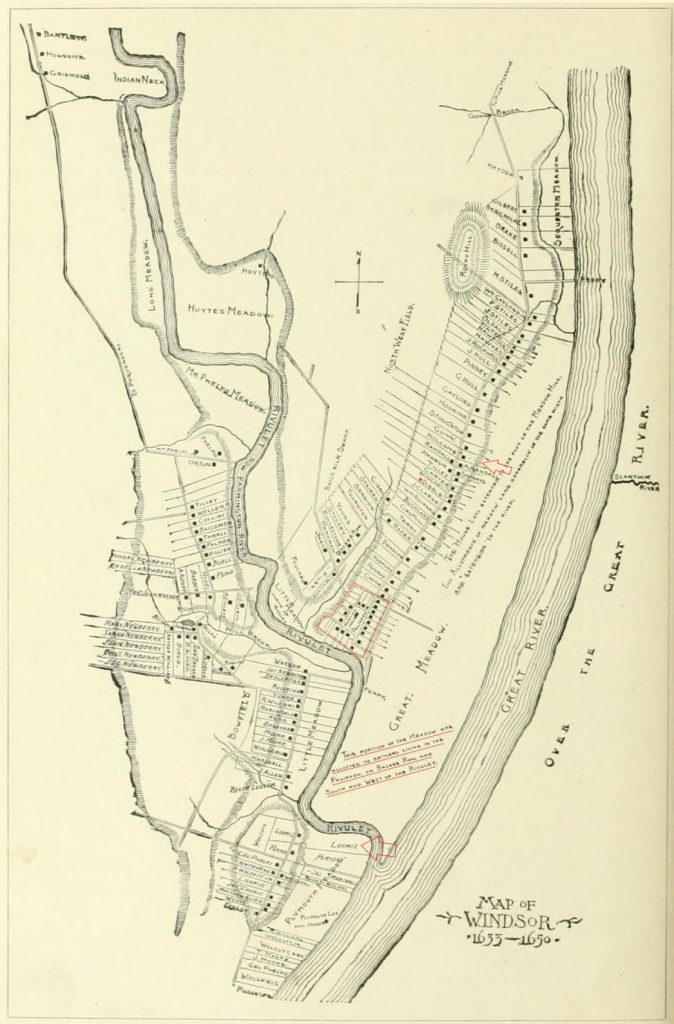
Joseph Loomis built as his first home, a dug-out cabin. His wood frame house was located on the “Island” near the mouth of the Farmington River, so called because at every great freshet it became temporarily an island by the overflowing of the Connecticut River. Cabin and house are both preserved on the grounds of the The Loomis Chaffee School, 4 Batchelder Road, in Windsor, Connecticut.
The Loomis home is a National Landmark. The oldest part of the house was built in 1640 by Joseph Loomis who came to America from England in 1638. One of the most remarkable facts in the history of the house on “The Islands” is that the title has come down through generation after generation by inheritance, and has never been transferred by deed. It is believed to be the oldest timber frame homestead now standing in the United States. According to Edward C. Marshall’s “Ancestors of General Grant,” the Loomis home is the oldest in America, with the exception of the Van Rensselaer homestead at Albany, N.Y. The latter place was a few years older, but it is said that this house has been moved away from Albany, leaving the Loomis homestead alone in its distinction.
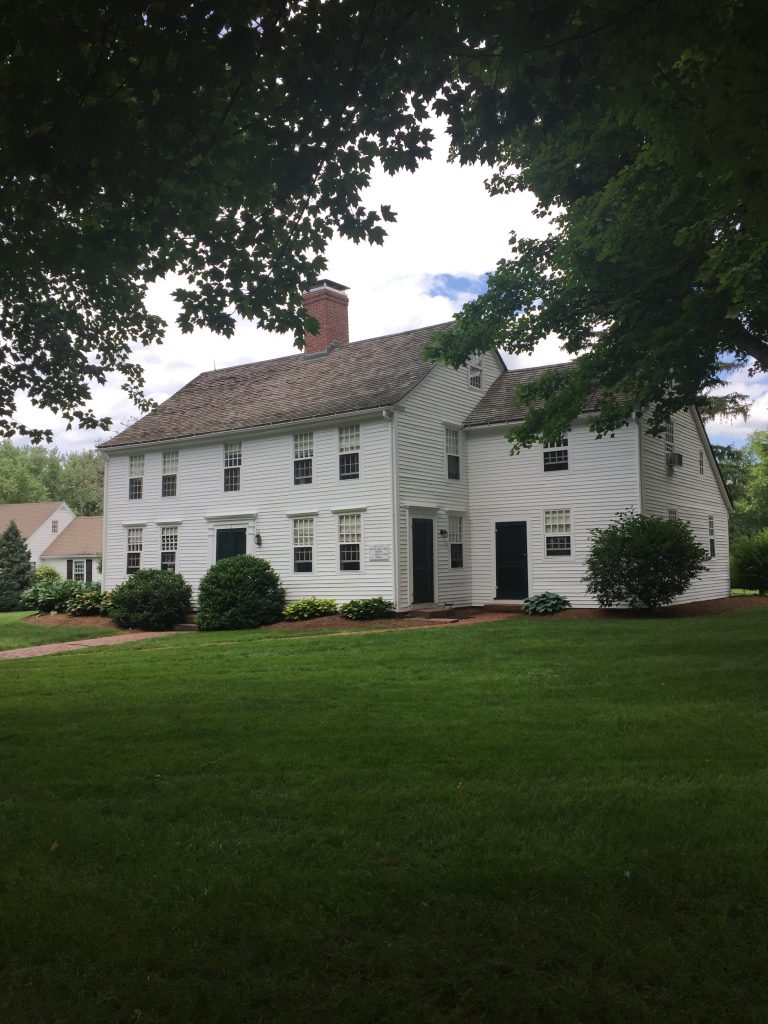
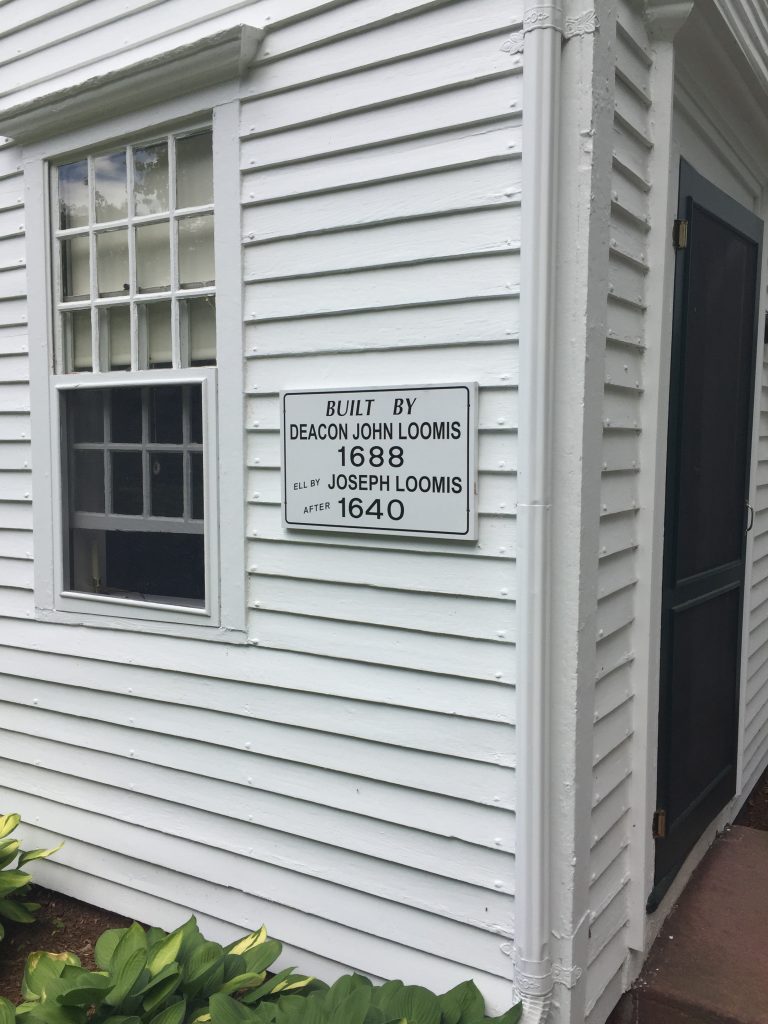
These Photos of the Loomis house were taken in 2017
The land for the school was donated by a distant cousin of the Michigan Loomis family: James Loomis (1779-1862) and his wife Abigail Chafee.
The immigrant’s son, Deacon John Loomis, was born in Essex, England in 1622 and married Elizabeth Scott on Feb. 3, 1648-9. Elizabeth was born in 1625 and died May 7, 1696. She was the daughter of Thomas and Ann Scott, who sailed from Ipswich, England, April, 1634, to Ipswich, Mass., and had with them their daughter Elizabeth, aged 9 years. They removed to Hartford, Conn.
He was admitted to the Windsor. Church Oct. 11, 1640. On May 3, 1643, and was granted from the Plantation, 40 acres of land. He resided in Farmington from 1652 to 1660 when he returned to Windsor and was Deacon of the church. He was a representative to the legislature 1666-7 and deputy to General Court 1666 and again in 1675-87. He served as constable for Windsor and as a juryman, seven times.
He constructed the second, larger wing to the Loomis homestead in 1686. They had 13 children – all born in Windsor except for Thomas, Samuel, Daniel (the current generations 9th GGrandfather), and James who were born in Farmington. He died Sept. 1, 1688, at the age of 66, and his monument is still preserved in the Windsor burying ground named on it as “Deacon John Lomas”.
The Will of John Loomis, Windsor dated 27 Aug. 1688. (Preserved in the Probate office at Hartford, CT) his name is signed John Loomys.
John Loomiss senior doe beinge of a competent understandinge and memory ordayne and appoynt this my Last will and Testament. In primis my will is that my eldest son John shall have a double portion of my estate in Land yt to bee accounted for part that he have already beene possessed of and by this I give liberty to bee assured of my will is that all my land on both sides ye River shall be equally devided between all my children now livinge I leave itt in charg in my will yt there bee indeavered of all a ready complyance to agree in ye devission itt beinge so small devissions I know not how to pleas myself nor them. My will isyt my daughter Elizabeth shall have equall portion with my sons excepting John of ye movable estae my will is yt my wife shall have ye product of ye thirds of all my land as longe as she lives and that ye house homested & Barne Remayne to my wife as longe as she lives and ye free dispose of itt amongst my children when she dies & thatt ye 3rd prt of my moveable estate of what she shall chuse to bee to her free dispose amongst my children.
You can read a history of the Loomis Family e-book or download a copy at this link
Reverend William Skepper 1597-1650 and Sarah Fisher
Skepper was a younger son by his father’s 2nd marriage, baptized at Boston, Lincolnshire 27 Nov. 1597. William’s parents were Edward and Mary Robinson Skepper. They are descended from a well-documented line of Royal ancestry, including King Edward III and further back to Charlemagne (descendancy chart below this biography). In the age of primogeniture, the eldest son was awarded the titles and lands and the other sons sought their fortunes in the clergy or military. William chose the former.
He obtained a B.A. degree at Sidney College, Cambridge University, 1617-8. He served a Rector of Thorpe-in-the-Marsh, Lincolnshire, 1630-8. He and his first wife had three sons and four daughters. She passed away and he married Sarah Fisher at Boston, Lincolnshire 17 Jan. 1638/9. They had one daughter, Sarah (ancestor). He and his family emigrated to New England in 1639.
The Emperor Charlemagne to Bruce, Claire, and Maggie Wamhoff (44 generations)
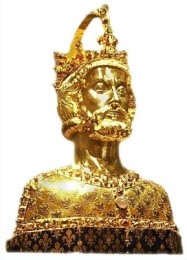
Emperor Charlemagne (742-814) =Hildegarde (41st ggrandparents) Emp. Louis I=Judith of Bavaria
Emp. Charles II=Ermentrude of Orleans
Judith=Baldwin I, C. of Flanders
Baldwin II, C. of Flanders=Elfrida of Wessex
Arnulf I, C. of Flanders=Adela of Vermandois
Baldwin III, C. of Flanders=Matilda of Saxony
Arnulf II, C. of Flanders=Rozela of Italy
Baldwin IV, C. of Flanders=Ogive of Luxembourg
Baldwin V, C. of Flanders=Adela of France
Matilda of Flanders=King William I of England (1028-1087) (31st ggrandparents) King Henry I of England=Matilda of Scotland
Matilda=Geoffrey Plantagenet, Count of Anjou
King Henry II of England=Eleanor of Aquitaine
King John of England (1166-1216)=Isabella of Angouleme (27th ggrandparents) King Henry III of England=Eleanor of Provence
King Edward I of England (1239-1307)=Eleanor of Castile-Leon (25th ggrandparents) King Edward II of England=Isabella of France
King Edward III of England=Philippa of Hainault
Lionel of Antwerp, D. of Clarence=Elizabeth de Burgh
Philippa of Clarence=Edmund de Mortimer, 3rd E. of March
Elizabeth Mortimer=Sir Henry ‘Hotspur’ Percy
Elizabeth Percy=John Clifford, 7th Lord Clifford
Mary Clifford=Sir Philip Wentworth
Elizabeth Wentworth=Sir Martin de la See
Joan de la See=Sir Peter Hildyard
Isabel Hildyard=Ralph Legard, Esq.
Joan Legard=Richard Skepper, Lord of Ingoldmels Manor
Edward Skepper, Lord of Ingoldmels Manor=Mary Robinson
Rev. William Skepper/Skipper (1597-1650)=Sarah Fisher (immigrants and 12th ggrandparents)
Sarah Skepper = Walter Fairfield
Prudence Fairfield = William Dodge
Prudence Dodge = Josiah Dodge
Eli Dodge = Abigail
Isaac Dodge = Elizabeth
Isaac Dodge = Eunice Wilson
Philinda Dodge = Benjamin Sneeden
Rachel Permelia Sneeden = George Washington Loomis
George Washington Loomis = Valeria L Phillips
Arnold Rae Loomis = Genevieve Cecelia Bunline
Arnold Clare Loomis = Joan Clara Brockman
Joan Marie Loomis = Fredrick Charles Wamhoff
Daniel Fredrick Wamhoff = Danielle Marie Fike
Bruce, Claire, and Margaret Wamhoff
Some interesting ancestors in this line in addition to Charlemagne himself are: William the Conqueror, King John of Magna Carta fame, Eleanor of Aquitaine, Harry Hotspur Percy, mentioned in Shakespeare’s plays Henry the Fourth.
Rev. William Skepper, the kids 12th ggrandfather, was recently added with a few others, to the confirmed database lineage of Charlemagne. Skipper [Skepper], William Reverend member reference number: 2125
http://www.charlemagne.org/ui84.htm#a0
William Skepper was also a descendant of the Magna Charta Barons:
http://www.magnacharta.com/articles/article06.htm
Loomis Revolutionary War Patriots
Seth Phillips
Seth Phillips not only served in the Revolutionary War, his service record also lists him as participating in the Lexington Alarm. He fought with the patriots on the day of the battles of Lexington and Concord. He was a minuteman soldier answering the militia call started by Paul Revere on April 19, 1775.
Seth was a resident of Pembroke, now Hanson about 20 miles southeast of Boston, so he was not able to join the fight until later in the day. The militia gathered to the battle through the day with about 75 men on the Lexington Green, round 500 at the Concord bridge, and by the end of the day the ranks of the minutemen increased to about 3,500 as Phillips and his comrades joined the fight.
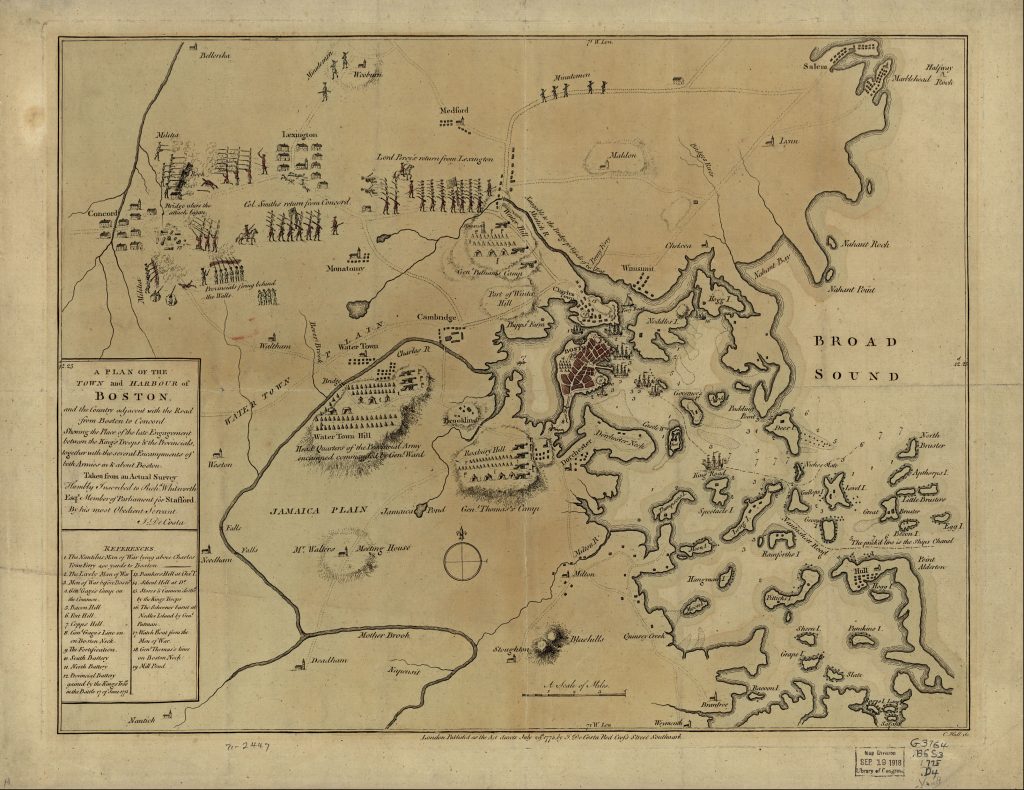

Phillips served as sergeant in Capt. James Hatch’s company, Lexington alarm, 1775; in Capt. Eleazer Hamlin’s company, siege of Boston, 1775 stationed With George Washington on The Dorchester Heights. On May 10, 1776 he was commissioned a lieutenant of the Pembroke company of militia, resigning his commission when he removed to Fitchburg in 1777. In this town he was one of the six months recruits for the Continental service from July 12 to December 10, 1780.
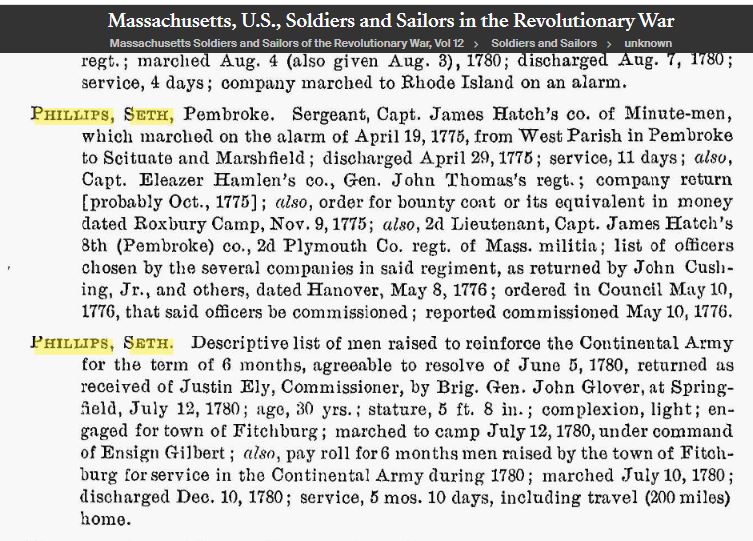
He was a son of Blaney and Christian (Wadsworth) Phillips born in Hanson, 1752. He married Betty Hamlin, an aunt of Vice-President Hannibal Hamlin, and removed to Fitchburg in 1777, where he died in 1828 and is buried in Laurel Hill cemetery.
Francis Loomis
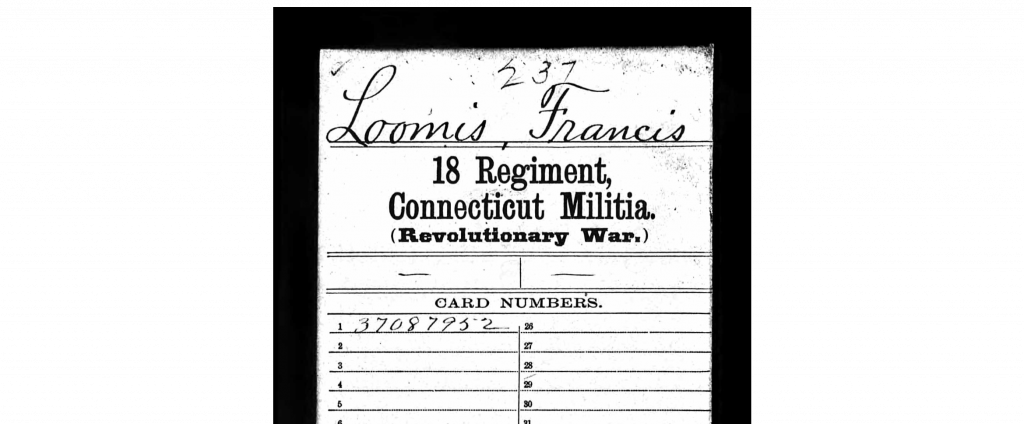
William Knapp
Served as a Corporal in Captain David McCamply’s company of The Orange County New York Militia during the Revolutionary War.
Isaac Dodge

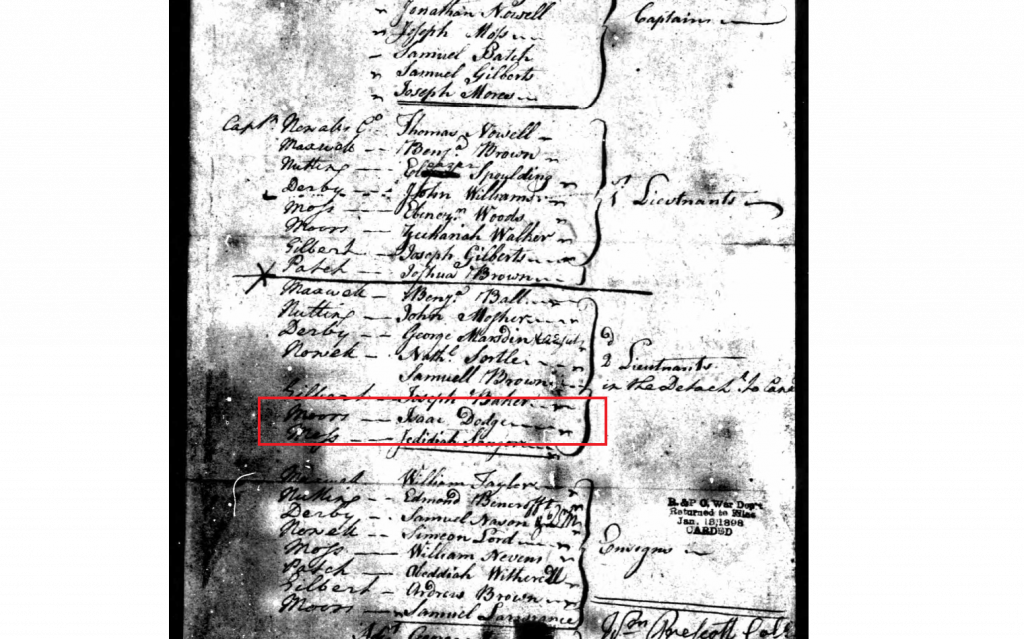
Christian Samuel Bachman
was born on May 19, 1727, in Lower Saucon, Pennsylvania, He was the son of Johann and Anna. He married Barbara in 1751 in his hometown. They had ten children. He owned a grist mill along the banks of the Saucon Creek. The mill was located on a portion of the 200 acres of property conveyed to him by Christian Beitler on 20 Jun 1751. He died on August 23, 1783, in Lower Milford, Pennsylvania, at the age of 56, and was buried in Ann, Minnesota.
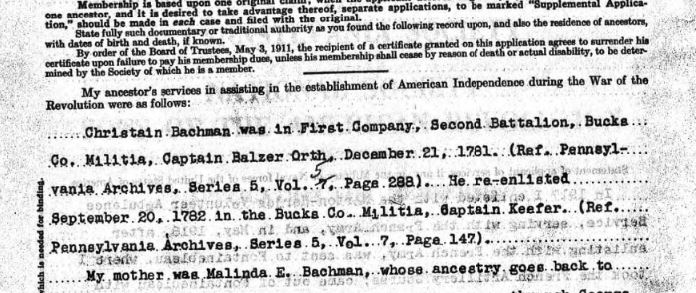
Thomas Hall
He was the son of Consider Hall & Abigail Parker. Brother of Hannah Hall and Abigail Hall. He enlisted as a private twice in the Revolutionary War: in 1777 he served two weeks and was at the Battle of Saratoga. In early June 1778 he served one and one-half months on “Indian alarms” in Capt. John Chadwick’s company, Col. Samuel Brewer’s regiment, Gen. Patterson’s brigade, Massachusetts line.